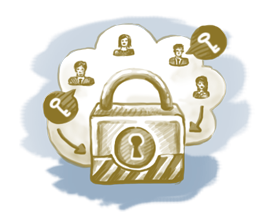Cloud computing technology is bringing about a whole new business CRM paradigm.
Steel and glass buildings, oppressive cubicles, office politics and traffic jams are being replaced with reporting to work over the web, virtual companies with staff scattered throughout the world, and individual freedom to contribute and create as never before.
Such an environment could never happen without adequate supporting technology. If we take a broad overall look, this technology can be broken down into three “Cs”: Communication, Collaboration and CRM (Customer Relationship Management). Discover more in this article:
#1: Communication
Of course the basic of any virtual business environment is the capability of fast communication. We’ve had the telephone for almost a century, but that in itself could never support a virtual business (if it could we would have had this model many years ago). In more modern times we’ve had email and instant messaging—but again those could not match the speed and visual qualities of live interaction.
It is only with the advent of widely available high-speed broadband internet that the possibilities began to finally unfold—and today they are here. There are an ever-increasing number of affordable platforms that make it readily possible for a meeting to take place with participants located in London, Albuquerque, Beijing, Sydney, Mumbai or anywhere else in the world, in a virtual environment that is as cozy and alive as a conference room. People can see and hear each other just as easily as they would in a physical gathering.
The next element adds the vital needed dimension for actually getting work done.
#2: Collaboration
In a live meeting, participants have the option to utilize visual aids such as whiteboards, charts, graphs and PowerPoint presentations. Developers of online meeting applications were quick to grasp this vital necessity and have made a wide variety of collaborative tools part and parcel of their offerings.
Today meeting participants can present hand-drawn sketches and charts as they would on a white board, share web pages they are viewing on their own devices, display charts and graphs they have created, and walk participants through entire presentations. Such collaborative tools even have an added advantage over live meetings: the viewer is always just a foot or so away from the presenter, can hear him or her clearly and can easily see what is being presented. If you’ve ever been late to a live meeting and were forced to take a seat or even stand in the back of the room, you know what an advantage this is.
These tools also allow input from meeting participants into documents being collaboratively created—something else that was not usually possible in physical gatherings.
There is yet another type of collaboration required to run a business—and that brings us to our third “C.”
 #3: CRM Solutions
#3: CRM Solutions
Any organization needs a central repository for customer data—containing vital elements such as contact data, products or services purchased, warranty or service contracts, and other important customer information. These have traditionally been kept in a CRM software.
But today’s virtual business environment presents a whole new level of challenges for CRM. Fortunately, there is innovative CRM software now on the market which meet these challenges.
To be fully supportive of today’s “new world” business, CRM should:
A: Follow a company’s sales process
A CRM solution must be quickly learnable and usable by salespeople and others who will need it. The best way for that to happen is for the CRM application to exactly mirror a company’s sales process—the exact series of steps take from lead to close. This intuitive, logical approach makes it possible for salespeople and other employees at all corners of the globe to easily grasp how to store and retrieve usable data from CRM.
B: Be compatible with other company applications
Any company including a virtual one will have applications they have been using and will continue to use. CRM should be compatible with at least the most important ones so that documents and files created with these applications can be easily stored right in CRM.
C: Contain powerful analysis and forecasting tools
In yesterday’s “brick-and-mortar” business model, sales analyses and forecasts required loads of extra time to research and to assemble. A leading-edge CRM solution makes it possible for these to be quickly and easily generated—even on the fly.
D: Be in the cloud and use cloud computing technology
A CRM solution is useless to a virtual business if all stakeholders cannot access CRM anytime, anywhere. Therefore any CRM solution chosen today must be available on handheld, tablet, notebook or any other device an employee, executive or sales rep might be using. A cloud CRM solution makes it possible for all data entered to be constantly synced, no matter where the data gets input.
Cloud computing technology is all about the three “Cs”
Cloud computing, containing these three “Cs” of operation, make it possible for the virtual business of tomorrow to exist—and be the be the hugely successful enterprise envisioned—today.
See our other articles on cloud computing and today”s revolutionairy business environment.





















